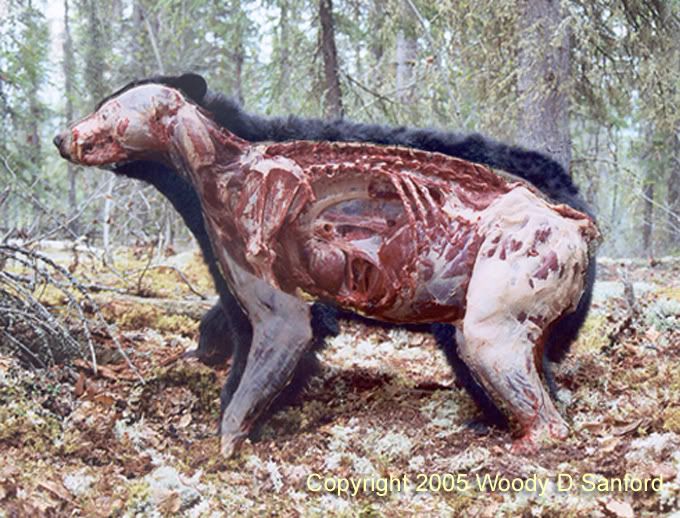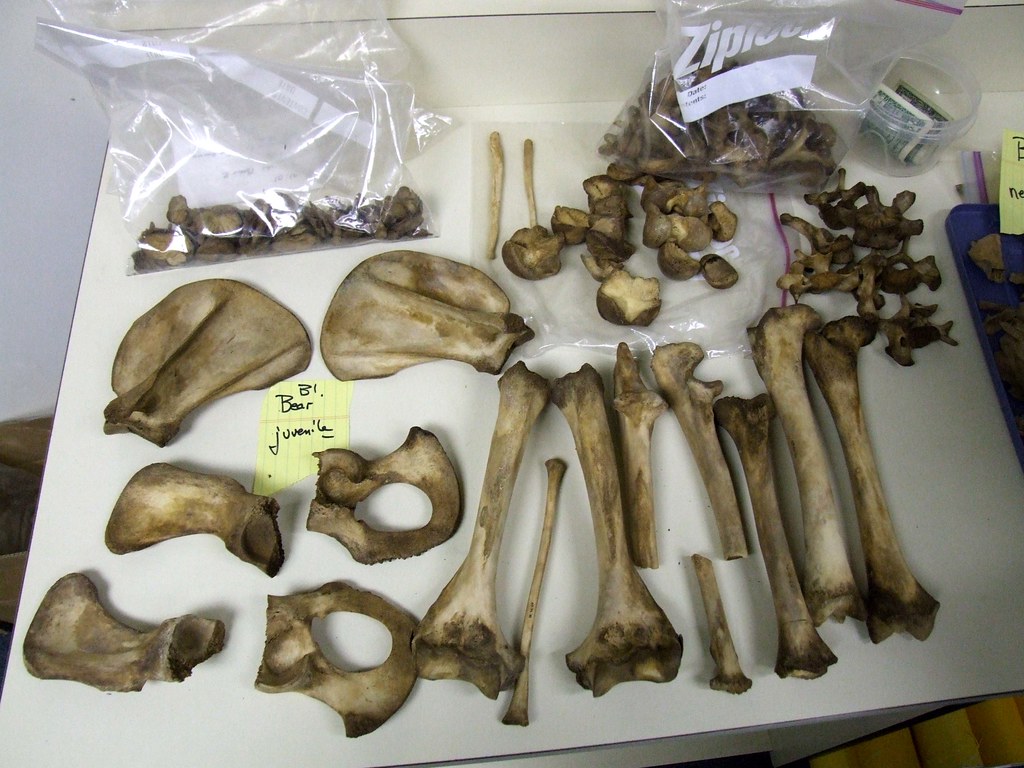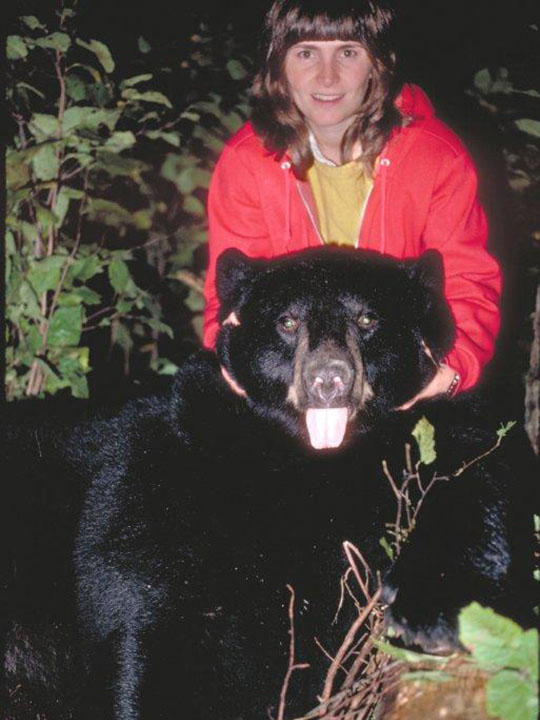|
|
GENERAL
May 22, 2011 8:44:11 GMT -9
Post by warsaw on May 22, 2011 8:44:11 GMT -9
|
|
|
|
Post by warsaw on Jul 4, 2011 5:36:33 GMT -9
|
|
|
|
GENERAL
Jul 21, 2011 14:24:54 GMT -9
Post by grrraaahhh on Jul 21, 2011 14:24:54 GMT -9
 Juvenile Black Bear These bones are from a bear of about a year or two in age. These bones are better visible than those of the newborn, although you can see that the pelvis isn't yet fully fused. Above the long bones sitting out on the plastic bag are the epiphyses or ends to the bones that never got the chance to fuse. With time and compression, they become fully formed with the long bone.  Thanks Warsaw. |
|
|
|
Post by warsaw on Jun 7, 2012 9:11:13 GMT -9
Black bears examined by biologists.   |
|
|
|
GENERAL
Aug 20, 2012 21:14:48 GMT -9
Post by Ursus arctos on Aug 20, 2012 21:14:48 GMT -9
In addition, some of the bears learned rapidly and showed positive
transfer with intermediate level discrimination, which were also
learned rapidly by orang-utan subjects (Vonk & MacDonald 2004),
but not by a gorilla (Vonk & MacDonald 2002). Intermediate-level
concepts correspond to the basic basic-level concepts acquired first
by young human children (Rosch et al. 1976). In showing that bears
are able to form concepts that cannot be acquired solely on the basis
of readily perceivable perceptual features, we have demonstrated
the capacity for abstract representation, which has not previously
been determined for this species, or for other species in this order.
Although the bears, on average, required more trials to reach
criterion than did a gorilla and orang-utans tested previously (Vonk
& MacDonald 2002, 2004), they acquired the discriminations more
rapidly than chimpanzees tested on the exact same discriminations
with the exact same procedure (J. Vonk, S. E. Jett & K. W. Mosteller,
unpublished data). While the bears on average required 22-33
sessions to reach criterion on the training sets across the different
tasks, the chimpanzees required, on average, 35-75 sessions to
reach the same criterion. While the orang-utans and the gorilla
received 10 trials within a session (thus fewer sessions to criterion
also means many fewer trials to criterion), the bears and chimpanzees
received 20-trial sessions. Also of note is the fact that the
orang-utans and the gorilla were required to meet a criterion of
only two consecutive sessions at 80% (8/10 correct choices) before
moving on to a novel set of images, while the bears and chimpanzees
were required to meet a more stringent criterion of four
consecutive sessions at 80% correct (16/20), or an average of 87.5%
correct across four consecutive sessions, or 90% correct for two
consecutive sessions. Had the less stringent criterion been adopted
here as well, both bears and chimpanzees would have required
fewer sessions to reach criterion. However, it is possible that
differences in the procedures resulted in better opportunity to
acquire and generalize the concepts being tested for the bears and
chimpanzees. Indeed, changes from the original procedure were
implemented in order to be more certain of concept acquisition
prior to presenting transfer, and to increase the likelihood of
forming a generalizable concept. All species were tested on
a similar schedule receiving 4-16 sessions per day, 2 or 3 days per
week over a period of several years. On the critical measure of
concept transfer, the bears’ performance once criteria had been
established was comparable to that of the apes at each level of
abstraction. Although there were differences in training that may
have affected acquisition of the concepts between (1) the orangutans
and the gorilla and (2) the bears and the chimpanzees, it is
less likely that such differences affected generalization of the
concepts. That these bears showed transfer comparable to apes
tested previously (Vonk & MacDonald 2002, 2004; J. Vonk, S. E. Jett
& K. W. Mosteller, unpublished data) suggests that phylogenetic
relatedness to humans and group living are not the only routes to
the capacity for abstraction. Of course, other factors, such as
physically challenging environments, most likely play a role in
complex cognition (Milton 1981, 1988; Emery & Clayton 2004), but
few nonsocial species have been tested in comparable tasks to
evaluate these hypotheses.From: Vonk, J., et al., Concept formation in American black bears, Ursus americanus, Animal Behaviour (2012), http:// dx.doi.org/10.1016/j.anbehav.2012.07.020 
|
|
|
|
GENERAL
Aug 21, 2012 11:29:29 GMT -9
Post by warsaw on Aug 21, 2012 11:29:29 GMT -9
In addition, some of the bears learned rapidly and showed positive
transfer with intermediate level discrimination, which were also
learned rapidly by orang-utan subjects (Vonk & MacDonald 2004),
but not by a gorilla (Vonk & MacDonald 2002). Intermediate-level
concepts correspond to the basic basic-level concepts acquired first
by young human children (Rosch et al. 1976). In showing that bears
are able to form concepts that cannot be acquired solely on the basis
of readily perceivable perceptual features, we have demonstrated
the capacity for abstract representation, which has not previously
been determined for this species, or for other species in this order.
Although the bears, on average, required more trials to reach
criterion than did a gorilla and orang-utans tested previously (Vonk
& MacDonald 2002, 2004), they acquired the discriminations more
rapidly than chimpanzees tested on the exact same discriminations
with the exact same procedure (J. Vonk, S. E. Jett & K. W. Mosteller,
unpublished data). While the bears on average required 22-33
sessions to reach criterion on the training sets across the different
tasks, the chimpanzees required, on average, 35-75 sessions to
reach the same criterion. While the orang-utans and the gorilla
received 10 trials within a session (thus fewer sessions to criterion
also means many fewer trials to criterion), the bears and chimpanzees
received 20-trial sessions. Also of note is the fact that the
orang-utans and the gorilla were required to meet a criterion of
only two consecutive sessions at 80% (8/10 correct choices) before
moving on to a novel set of images, while the bears and chimpanzees
were required to meet a more stringent criterion of four
consecutive sessions at 80% correct (16/20), or an average of 87.5%
correct across four consecutive sessions, or 90% correct for two
consecutive sessions. Had the less stringent criterion been adopted
here as well, both bears and chimpanzees would have required
fewer sessions to reach criterion. However, it is possible that
differences in the procedures resulted in better opportunity to
acquire and generalize the concepts being tested for the bears and
chimpanzees. Indeed, changes from the original procedure were
implemented in order to be more certain of concept acquisition
prior to presenting transfer, and to increase the likelihood of
forming a generalizable concept. All species were tested on
a similar schedule receiving 4-16 sessions per day, 2 or 3 days per
week over a period of several years. On the critical measure of
concept transfer, the bears’ performance once criteria had been
established was comparable to that of the apes at each level of
abstraction. Although there were differences in training that may
have affected acquisition of the concepts between (1) the orangutans
and the gorilla and (2) the bears and the chimpanzees, it is
less likely that such differences affected generalization of the
concepts. That these bears showed transfer comparable to apes
tested previously (Vonk & MacDonald 2002, 2004; J. Vonk, S. E. Jett
& K. W. Mosteller, unpublished data) suggests that phylogenetic
relatedness to humans and group living are not the only routes to
the capacity for abstraction. Of course, other factors, such as
physically challenging environments, most likely play a role in
complex cognition (Milton 1981, 1988; Emery & Clayton 2004), but
few nonsocial species have been tested in comparable tasks to
evaluate these hypotheses.From: Vonk, J., et al., Concept formation in American black bears, Ursus americanus, Animal Behaviour (2012), http:// dx.doi.org/10.1016/j.anbehav.2012.07.020  Thanks  |
|
|
|
GENERAL
Nov 25, 2012 14:17:00 GMT -9
Post by divingwolf on Nov 25, 2012 14:17:00 GMT -9
American Black Bear rear foot print Quesnel BC Canada 4 November 2012 Attachments:
|
|
|
|
GENERAL
Nov 25, 2012 20:57:39 GMT -9
Post by grrraaahhh on Nov 25, 2012 20:57:39 GMT -9
Thanks again divingwolf. I need more Canadians to join this forum. By any chance, can you tell me the name of the Canadian wildlife agency that manages Haida Gwaii black bears?
|
|
|
|
GENERAL
Nov 26, 2012 9:36:12 GMT -9
Post by divingwolf on Nov 26, 2012 9:36:12 GMT -9
The Ministry of Forests, Lands and Natural Resource Operations Fish, Wildlife and Habitat Management Branch www.env.gov.bc.ca/fw/ |
|
|
|
GENERAL
Nov 26, 2012 10:51:59 GMT -9
Post by divingwolf on Nov 26, 2012 10:51:59 GMT -9
|
|
|
|
GENERAL
Nov 26, 2012 12:34:13 GMT -9
Post by divingwolf on Nov 26, 2012 12:34:13 GMT -9
I have just discovered another link: BC Ministry of Environment, Ecosystems Branch, Grizzly Bear Management www.env.gov.bc.ca/wld/grzz/I know that you asked about the management of Haida Gwaii Black Bears, not Grizzly Bears. But if this Ecosystems Branch is involved in Grizzly Bear management, they may concern themselves with Black Bears as well. One would have to look through their pages. |
|
|
|
GENERAL
Nov 26, 2012 17:36:04 GMT -9
Post by divingwolf on Nov 26, 2012 17:36:04 GMT -9
If a bear is reported as causing problems, a conservation officer will check out the situation. Sometimes bears are relocated, at other times they are killed. www.env.gov.bc.ca/cos/ |
|
|
|
Post by warsaw on Apr 1, 2013 5:46:47 GMT -9
|
|
|
|
Post by warsaw on Apr 7, 2013 3:01:40 GMT -9
www.bearstudy.org/website/images/stories/images/Daily_Updates/20121206_Donna_with_big_bear_at_dump_1982.jpg A few weeks later on September 13, 1982, Lynn and Donna were part of a wolf capture operation at the dump. Somehow that night, the same huge bear ended up in a foot snare. Lynn tranquilized and weighed it (611 pounds)—the heaviest bear he captured in his 45 years of research to this day. Donna Rogers held up the big, handsome head for the picture. Lynn radio-collared the male and a few weeks later tracked it to its den. That’s when he began to learn that very fat bears are among the earliest bears to den, denning nearly as early as pregnant females. On March 19, 1983, Lynn quietly approached the den, which was no more than a nest next to some upturned roots. He peered over the roots, and tranquilized the bear. The bear woke up upon being stuck, looked at Lynn and walked off. Lynn tracked the bear to where the tranquilizers took place. There they took blood samples, measurements, a weight (447 pounds), and removed the radio-collar. Donna was along on that trip, too. Good memories of the excitement of learning. www.bearstudy.org/website/updates/daily-updates/1832-a-story-update-december-6-2012-.html
|
|
|
|
GENERAL
Jan 22, 2015 1:24:27 GMT -9
Post by warsaw on Jan 22, 2015 1:24:27 GMT -9
Alaska Photographer Michael Glidden Captures Picture of Bear in Hibernation Inside Retreating Glacier Few people will ever see what Michael Glidden stumbled upon in the Alaskan wilderness. While photographing nature on Dec. 13, Glidden and his two dogs were exploring ice caves in south-central Alaska's Chugach National Forest. The dogs were leading the way with Glidden close behind, snapping pictures of the chilly landscape. (MORE: 7 Big Changes Happening in the Arctic) It wasn't until Glidden returned home and started analyzing the pictures that he realized they almost walked right into a hibernating black bear inside one of the ice caves, as seen in the gallery above. "My flash showed that all the while I had been only yards from a hibernating black bear," he told The Weather Channel. Aside from the incredible stroke of luck in spotting the bear, Glidden's photos show a major problem developing in colder regions of the Northern Hemisphere – many of our glaciers are melting. He's seen a notable decline in the size of glaciers in photos he's taken that only date back four years, he told The Weather Channel. (PHOTOS: See Glaciers in Retreat, as Seen by Photographers) Alaska has been locked into warmer-than-normal temperatures for much of the fall and winter so far, even as the Lower 48 froze through a frigid November. Into the Lair of the Bear  www.weather.com/science/nature/news/alaska-photographer-bear-in-hibernation?cm_ven=Facebook_TheWeatherChannel_Science_JKo_Article_No_1_20141224 www.weather.com/science/nature/news/alaska-photographer-bear-in-hibernation?cm_ven=Facebook_TheWeatherChannel_Science_JKo_Article_No_1_20141224 |
|